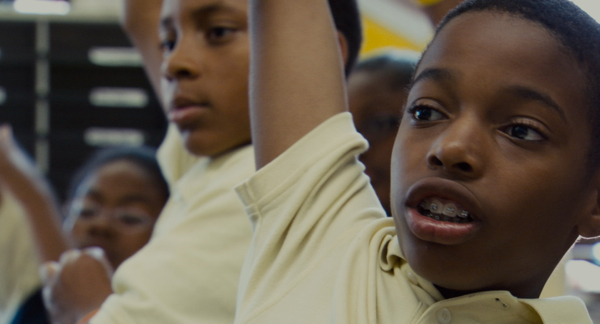Movie review by Greg Carlson
Only the naïve would argue that a single, feature documentary has the necessary platform and scale to effectively tackle an issue as complex and frustrating as the woefully underfunded American public education system, and Davis Guggenheim’s “Waiting for ‘Superman’” has been criticized for the narrowness of its vision, which appears to be substantially poorer than the Man of Steel’s eyesight. A grim and sobering contrast from the director’s rock guitar exploration “It Might Get Loud,” “Waiting for ‘Superman’” returns to the filmmaker’s roots as social advocate, incorporating brief clips from Guggenheim’s 2001 PBS-aired work “The First Year,” which followed five teachers through their initial school year. “Waiting for ‘Superman’” will at least superficially and temporarily attract attention to educational issues, and this represents one measure of the movie’s success.
Like Guggenheim’s Academy Award-winning “An Inconvenient Truth,” “Waiting for ‘Superman’” relies heavily on graphics-intensive statistics, here rendered through a series of animations created by Sean Donnelly and a team from Awesome + Modest. The impact of these images is much closer to the use of animation in “This Film Is Not Yet Rated” than “Waltz with Bashir,” and occasionally the result feels facile and streamlined. Along with the animated sequences, Guggenheim uses plenty of stock footage, including one memorable sequence outlining the post-World War II potency of United States public education. Talking head interviews, which include an appearance by Bill Gates, are also plentiful.
Editorial elision creates problematic “good guys versus bad guys” scenarios, embodied most dramatically in the positioning of American Federation of Teachers president Randi Weingarten as a diabolical bully, protecting incompetent screw-ups behind the shield of a powerful union. Guggenheim includes horrifying, clandestinely shot footage of a derelict educator completely ignoring students, as well as the so-called “rubber room” in New York, where teachers who had been removed from classrooms and were awaiting disciplinary hearings collected full salaries while spending their days playing cards, sleeping, or reading.
The “good guys” emerge in the figures of District of Columbia Public Schools chancellor Michelle Rhee (who announced her resignation on October 13, 2010) and activist, reformer and educator Geoffrey Canada, leader of the Harlem Children’s Zone. Rhee’s crusade to radically alter business as usual within her school system by targeting bad teachers, firing principals and administrators, and attempting to implement merit pay while dismantling aspects of the oft-maligned tenure policy is highlighted by Guggenheim as an example of the intractability of the teacher’s union as a monolithic juggernaut. Canada passionately endorses charter schools – an educational model which the film strongly positions as a potential solution to the crisis – and shares the anecdote that provides the movie’s title.
Guggenheim builds to a heartbreaking dramatic climax by cutting together scenes of several families whose children the film has been following as they wait on pins and needles to be chosen by lottery for acceptance at charter institutions. In most cases, the odds are daunting, crushing even, and the entire sequence resonates with Kryptonite-like debilitation, especially when it becomes clear that most of the endings are not going to be happy. “Waiting for ‘Superman’” has attracted outspoken opposition, including the critique of University of San Francisco adjunct education professor Rick Ayers, who argues that the movie shortsightedly endorses the privatization and corporatization of our schools. Whether or not Ayers is correct, “Waiting for ‘Superman’” should be seen and discussed.
